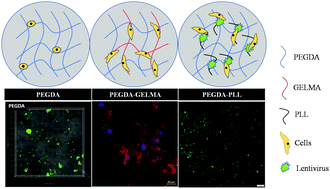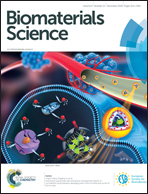Efficient in situ gene delivery via PEG diacrylate matrices†
Abstract
For diseases related to genetic disorders or cancer, many cellular therapies rely on the ex vivo modification of cells for attaining a desired therapeutic effect. The efficacy of such therapies involving the genetic modification of cells relies on the extent of gene expression and subsequent persistence of modified cells when infused into the patient's body. In situ gene delivery implies the manipulation of cells in their in vivo niche such that the effectiveness can be improved by minimizing post manipulation effects like cell death, lack of persistence, etc. Furthermore, material-based in situ localized gene delivery can reduce the undesired side effects caused by systemic modifications. Here, we have used polyethylene (glycol) diacrylate (PEGDA) based cryogels to genetically modify cells in vivo with a focus on immunotherapy. PEGDA cryogels were either blended with gelatin methacrylate (GELMA) or surface modified with poly-L-lysine (PLL) in order to improve cell adhesion and/or retain viruses for localized gene delivery. On using the lentiviruses encoding gene for green fluorescent protein (GFP) in in vitro experiments, we found higher transduction efficiency in HEK 293FT cells via PEGDA modified with poly-L-lysine (PEGDA–PLL) and PEGDA–GELMA cryogels compared to PEGDA cryogels. In vitro release experiments showed improved retention of GFP lentiviruses in PEGDA–PLL cryogels, which were then employed for in vivo gene delivery and were demonstrated to perform better than the corresponding bolus delivery of lentiviruses through an injection. Both physical and biological characterization studies of these cryogels show that this material platform can be used for gene delivery as well as other tissue engineering applications.



 Please wait while we load your content...
Please wait while we load your content...